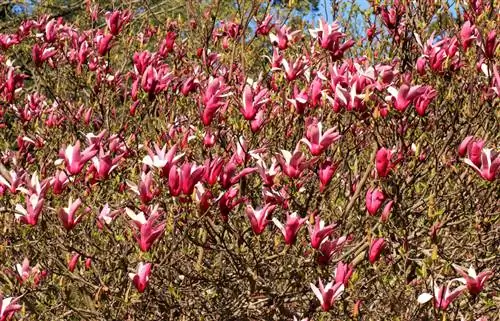- Author admin [email protected].
- Public 2023-12-16 16:46.
- Last modified 2025-01-23 11:20.
Sal willow belongs to the willow genus of the willow family. Their flowers appear long before the leaves emerge and herald spring. The flowers are called pussy willows and are valued in this country as an important source of food for bees.

What characterizes the sal willow?
The Sal willow (Salix caprea) is a deciduous tree or shrub that can grow up to 10 m high. It has grey-black bark, dark green leaves and bears male or female silvery-yellow catkins as flowers. The sal willow prefers sunny locations and nutrient-rich soils.
Sal willow is not only a valuable source of food for insects. The plant, which blooms early in the year, is also popular with people. Because of its fluffy flowers, it is affectionately called pussy willow or catkin and is often used for Easter arrangements.
Systematics and description
- Type: Sal willow, also Sal willow (Salix caprea)
- Genus: Willows (Salix)
- Family: Willow family (Salicaceae)
- Growth: as a deciduous, upright, moderately branched tree or as a shrub. The trees reach heights of up to 10 m, the bushes are more compact at around 3-5 m.
- Bark: gray to black-brown and with longitudinal cracks.
- Leaves: elongated with sunken leaf veins, dark green on the upper side in summer, shimmering silver on the underside, turning yellow-brown in autumn.
- Flowers: The willows bear either only male or only female flowers. The so-called pussy willows are initially silvery furry, later bright yellow.
Dissemination and use
Salix caprea is found in both central and northern and southern Europe and most parts of Asia. In addition to being used as a beekeeping plant, willows are also often planted on roadsides and to fortify slopes and banks. They grow as pioneer trees in rubble heaps and dumps. Its bark contains tannins, which is why the willow is also important in medicine.
Location, cultivation and care
Salweide prefers a sunny location, but can also tolerate light shade. The soil should be nutrient-rich and fresh. Salix caprea is absolutely frost hardy and can be planted as soon as the ground is no longer frozen. In the spring after flowering, a vigorous pruning can be carried out; if necessary, moderate pruning can be carried out again in the summer. Propagation takes place via cuttings.
Tip
Salix caprea is not particularly suitable for living tents or teepees because it is difficult to weave and breaks easily. It is better to use osier (Salix viminalis) for these purposes.






